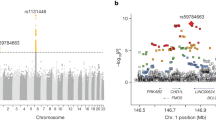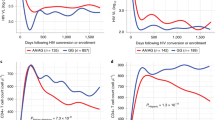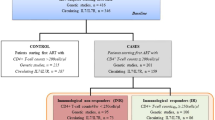Abstract
Heme oxygenase-1 (HO-1) is an anti-inflammatory enzyme that maintains homeostasis during cellular stress. Given previous findings that shorter length variants of a HO-1 promoter region GTn microsatellite polymorphism are associated with increased HO-1 expression in cell lines, we hypothesized that shorter variants would also be associated with increased levels of HO-1 expression, less inflammation and lower levels of inflammation-associated viral replication in human immunodeficiency virus (HIV)-infected subjects. Healthy donors (n=20) with shorter GTn repeats had higher HO-1 mRNA transcript in peripheral blood mononuclear cells stimulated with lipopolysaccharide (r=−0.38, P=0.05). The presence of fewer GTn repeats in subjects with untreated HIV disease was associated with higher HO-1 mRNA levels in peripheral blood (r=−0.41, P=0.02); similar observations were made in CD14+ monocytes from antiretroviral-treated subjects (r=−0.36, P=0.04). In African-Americans, but not Caucasians, greater GTn repeats were correlated with higher soluble CD14 levels during highly active antiretroviral therapy (r=0.38, P=0.007) as well as higher mean viral load off-therapy (r=0.24, P=0.04). These data demonstrate that the HO-1 GTn microsatellite polymorphism is associated with higher levels of HO-1 expression and that this pathway may have important effects on the association between inflammation and HIV replication.
This is a preview of subscription content, access via your institution
Access options
Subscribe to this journal
Receive 6 digital issues and online access to articles
$119.00 per year
only $19.83 per issue
Buy this article
- Purchase on Springer Link
- Instant access to full article PDF
Prices may be subject to local taxes which are calculated during checkout





Similar content being viewed by others
References
Hellerstein M, Hanley MB, Cesar D, Siler S, Papageorgopoulos C, Wieder E et al. Directly measured kinetics of circulating T lymphocytes in normal and hiv-1-infected humans. Nat Med 1999; 5: 83–89.
Hazenberg MD, Stuart JW, Otto SA, Borleffs JC, Boucher CA, de Boer RJ et al. T-cell division in human immunodeficiency virus (HIV)-1 infection is mainly due to immune activation: A longitudinal analysis in patients before and during highly active antiretroviral therapy (HAART). Blood 2000; 95: 249–255.
Kinoshita S, Su L, Amano M, Timmerman LA, Kaneshima H, Nolan GP . The T cell activation factor nf-atc positively regulates HIV-1 replication and gene expression in T cells. Immunity 1997; 6: 235–244.
Matsuyama T, Kobayashi N, Yamamoto N . Cytokines and HIV infection: is AIDS a tumor necrosis factor disease? AIDS 1991; 5: 1405.
Poli G, FAUCI AS. The effect of cytokines and pharmacologic agents on chronic HIV infection. AIDS Res Hum Retroviruses 1992; 8: 191–197.
Haase AT . Early events in sexual transmission of HIV and SIV and opportunities for interventions. Annu Rev Med 2010; 62: 127–139.
Deeks SG, Kitchen CM, Liu L, Guo H, Gascon R, Narváez AB et al. Immune activation set point during early HIV infection predicts subsequent CD4+ T-cell changes independent of viral load. Blood 2004; 104: 942–947.
Hunt PW, Martin JN, Sinclair E, Bredt B, Hagos E, Lampiris H et al. T cell activation is associated with lower CD4+ T cell gains in human immunodeficiency virus-infected patients with sustained viral suppression during antiretroviral therapy. J Infect Dis 2003; 187: 1534–1543.
Giorgi JV, Hultin LE, McKeating JA, Johnson TD, Owens B, Jacobson LP et al. Shorter survival in advanced human immunodeficiency virus type 1 infection is more closely associated with T lymphocyte activation than with plasma virus burden or virus chemokine coreceptor usage. J Infect Dis 1999; 179: 859–870.
Brenchley JM, Price DA, Schacker TW, Asher TE, Silvestri G, Rao S et al. Microbial translocation is a cause of systemic immune activation in chronic HIV infection. Nat Med 2006; 12: 1365–1371.
Baroncelli S, Galluzzo CM, Pirillo MF, Mancini MG, Weimer LE, Andreotti M et al. Microbial translocation is associated with residual viral replication in heart-treated HIV+ subjects with <50copies/ml HIV-1 RNA. J Clin Virol 2009; 46: 367–370.
Sandler NG, Wand H, Roque A, Law M, Nason MC, Nixon DE et al. Plasma levels of soluble CD14 independently predict mortality in HIV infection. J Infect Dis 2011; 203: 780–790.
Cassol E, Malfeld S, Mahasha P, van der Merwe S, Cassol S, Seebregts C et al. Persistent microbial translocation and immune activation in HIV-1-infected South Africans receiving combination antiretroviral therapy. J Infect Dis 2010; 202: 723–733.
Ryter SW, Alam J, Choi AM . Heme oxygenase-1/carbon monoxide: from basic science to therapeutic applications. Physiol Rev 2006; 86: 583–650.
Burt TD, Seu L, Mold JE, Kappas A, McCune JM . Naive human T cells are activated and proliferate in response to the heme oxygenase-1 inhibitor tin mesoporphyrin. J Immunol 2010; 185: 5279–5288.
Exner M, Minar E, Wagner O, Schillinger M . The role of heme oxygenase-1 promoter polymorphisms in human disease. Free Radic Biol Med 2004; 37: 1097–1104.
Yamada N, Yamaya M, Okinaga S, Nakayama K, Sekizawa K, Shibahara S et al. Microsatellite polymorphism in the heme oxygenase-1 gene promoter is associated with susceptibility to emphysema. Am J Hum Genet 2000; 66: 187–195.
Chen YH, Lin SJ, Lin MW, Tsai HL, Kuo SS, Chen JW et al. Microsatellite polymorphism in promoter of heme oxygenase-1 gene is associated with susceptibility to coronary artery disease in type 2 diabetic patients. Hum Genet 2002; 111: 1–8.
Ono K, Mannami T, Iwai N . Association of a promoter variant of the heme oxygenase-1 gene with hypertension in women. J Hypertens 2003; 21: 1497–1503.
Hirai H, Kubo H, Yamaya M, Nakayama K, Numasaki M, Kobayashi S et al. Microsatellite polymorphism in heme oxygenase-1 gene promoter is associated with susceptibility to oxidant-induced apoptosis in lymphoblastoid cell lines. Blood 2003; 102: 1619–1621.
Taha H, Skrzypek K, Guevara I, Nigisch A, Mustafa S, Grochot-Przeczek A et al. Role of heme oxygenase-1 in human endothelial cells: lesson from the promoter allelic variants. Arterioscler Thromb Vasc Biol 2010; 30: 1634–1641.
He Z, Hu Y, Feng L, Lu Y, Bao D, Xi Y et al. Association between HMOX-1 genotype and cardiac function during exercise. Appl Physiol Nutr Metab 2008; 33: 450–460.
Levere RD, Staudinger R, Loewy G, Kappas A, Shibahara S, Abraham NG . Elevated levels of heme oxygenase-1 activity and mRNA in peripheral blood adherent cells of acquired immunodeficiency syndrome patients. Am J Hematol 1993; 43: 19–23.
Hiki N, Berger D, Prigl C, Boelke E, Wiedeck H, Seidelmann M et al. Endotoxin binding and elimination by monocytes: secretion of soluble CD14 represents an inducible mechanism counteracting reduced expression of membrane CD14 in patients with sepsis and in a patient with paroxysmal nocturnal hemoglobinuria. Infect Immun 1998; 66: 1135–1141.
Bazil V, Strominger JL . Shedding as a mechanism of down-modulation of CD14 on stimulated human monocytes. J Immunol 1991; 147: 1567–1574.
Chauveau C, Rémy S, Royer PJ, Hill M, Tanguy-Royer S, Hubert FX et al. Heme oxygenase-1 expression inhibits dendritic cell maturation and proinflammatory function but conserves IL-10 expression. Blood 2005; 106: 1694–1702.
Locher C, Vanham G, Kestens L, Kruger M, Ceuppens JL, Vingerhoets J et al. Expression patterns of fc gamma receptors, HLA-DR and selected adhesion molecules on monocytes from normal and HIV-infected individuals. Clin Exp Immunol 1994; 98: 115–122.
Thieblemont N, Weiss L, Sadeghi HM, Estcourt C, Haeffner-Cavaillon N . cd14lowcd16high: a cytokine-producing monocyte subset which expands during human immunodeficiency virus infection. Eur J Immunol 1995; 25: 3418–3424.
Pulliam L, Gascon R, Stubblebine M, McGuire D, McGrath MS . Unique monocyte subset in patients with AIDS dementia. Lancet 1997; 349: 692–695.
Herbert A, Rich A . The biology of left-handed Z-DNA. J Biol Chem 1996; 271: 11595.
Ashino T, Yamanaka R, Yamamoto M, Shimokawa H, Sekikawa K, Iwakura Y et al. Negative feedback regulation of lipopolysaccharide-induced inducible nitric oxide synthase gene expression by heme oxygenase-1 induction in macrophages. Mol Immunol 2008; 45: 2106–2115.
Brunt KR, Fenrich KK, Kiani G, Tse MY, Pang SC, Ward CA et al. Protection of human vascular smooth muscle cells from h2o2-induced apoptosis through functional codependence between HO-1 and AKT. Arterioscler Thromb Vasc Biol 2006; 26: 2027–202.
Miyazaki T, Kirino Y, Takeno M, Samukawa S, Hama M, Tanaka M et al. Expression of heme oxygenase-1 in human leukemic cells and its regulation by transcriptional repressor bach1. Cancer Sci 2010; 101: 1409–1416.
Weatherall DJ, Clegg JB . Inherited haemoglobin disorders: an increasing global health problem. Bull World Health Organ 2001; 79: 704–712.
Sabeti PC, Varilly P, Fry B, Lohmueller J, Hostetter E, Cotsapas C et al. Genome-wide detection and characterization of positive selection in human populations. Nature 2007; 449: 913–918.
Bharucha AE, Kulkarni A, Choi KM, Camilleri M, Lempke M, Brunn GJ et al. First-in-human study demonstrating pharmacological activation of heme oxygenase-1 in humans. Clin Pharmacol Ther 2010; 87: 187–190.
Acknowledgements
We would like to thank all participants from the San Francisco General Hospital and San Francisco Veteran Affairs Medical centers. We would like to thank Dr David Williamson for his help in setting up the HO-1 SNP assay as well as curation of DNA samples. L.S. was supported by a pre-doctoral dissertation California HIV Research Program Grant (#D09-SF-313). During the period in which this work was carried out, T.D.B. was a fellow of the Pediatric Scientist Development Program and was supported by the American Pediatric Society, the American Academy of Pediatrics and the March of Dimes. J.M.M. was supported by NIH Awards U01 AI43641 and R37 AI40312, and is the recipient of the National Institutes of Health Director's Pioneer Award, part of the National Institutes of Health Roadmap for Medical Research, through Grant DPI OD00329. The SCOPE cohort was supported by the Centers for AIDS Research at UCSF (PO AI27763), CFAR Network of Integrated Systems (R24 AI067039), the UCSF CTSI (UL1 RR024131), NIAID (RO1 AI087145, K24AI069994, AI-76174, amfAR and the Ragon Institute. We would also like to thank Christopher R. Gignoux for critical discussion during the preparation of the manuscript.
Author information
Authors and Affiliations
Corresponding author
Ethics declarations
Competing interests
The authors declare no conflict of interest.
Additional information
Supplementary Information accompanies the paper on Genes and Immunity website
Supplementary information
Rights and permissions
About this article
Cite this article
Seu, L., Burt, T., Witte, J. et al. Variations in the heme oxygenase-1 microsatellite polymorphism are associated with plasma CD14 and viral load in HIV-infected African-Americans. Genes Immun 13, 258–267 (2012). https://doi.org/10.1038/gene.2011.76
Received:
Revised:
Accepted:
Published:
Issue Date:
DOI: https://doi.org/10.1038/gene.2011.76
Keywords
This article is cited by
-
Developments in Neuroprotection for HIV-Associated Neurocognitive Disorders (HAND)
Current HIV/AIDS Reports (2022)
-
The role of host defences in Covid 19 and treatments thereof
Molecular Medicine (2020)
-
Neuroinflammation associates with antioxidant heme oxygenase-1 response throughout the brain in persons living with HIV
Journal of NeuroVirology (2020)
-
Heme oxygenase-1 promoter region (GT)n polymorphism associates with increased neuroimmune activation and risk for encephalitis in HIV infection
Journal of Neuroinflammation (2018)
-
Levels of circulating myeloid subpopulations and of heme oxygenase-1 do not predict CD4+ T cell recovery after the initiation of antiretroviral therapy for HIV disease
AIDS Research and Therapy (2014)



